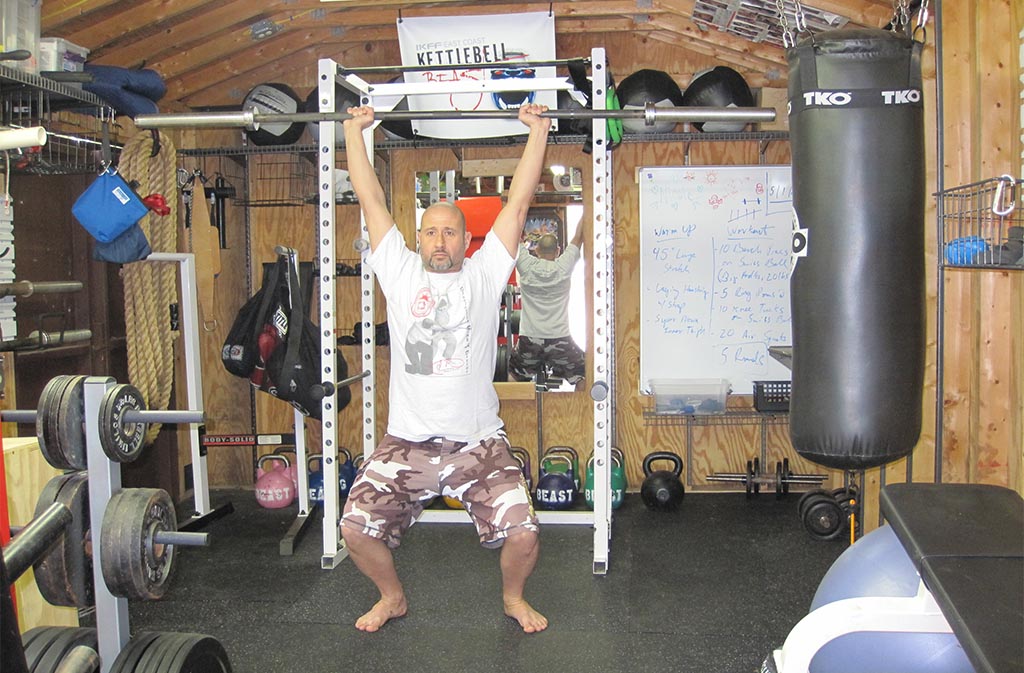Shoulder Press Guide: How to Press Overhead Safely & Build Strength
This is a guest blog post by Adam Farrah, author of The Paleo Dieter’s Missing Link and Functional Fitness, Kettlebell, Yoga and Meditation coach.

The press is the simple act of picking up an object and raising it overhead using the muscles of the shoulders and arms. It requires the legs and core to stabilize the body during the movement and is, in effect, a "total-body" exercise.
Pressing heavy weights over your head should be one of the cornerstones of your strength training life, right up there with squats, but if you're doing it wrong, you're cheating yourself out of the benefits of this incredible exercise.
Why the Shoulder Press Should Be a Cornerstone in Your Strength Routine
The shoulder (or overhead) press isn’t just a shoulder exercise—it drives core stabilization, functional upper-body strength, and posture improvement. When done with proper form, it strengthens your deltoids, triceps, and upper back while training your midline and hips to hold the position stable. Regularly incorporating the press can elevate your performance in other presses and lifts, reduce injury risk, and improve your physique.
To get your press back on track, we've formulated this Ultimate Guide.
In this article, you will learn:
- Foundation techniques you need to know before shoulder pressing
- How to do a shoulder press
- Advanced shoulder press techniques
- Shoulder building workouts
Before You Shoulder Press, Do These Exercises
Stabilizing a weight overhead is the foundation of a strong press. If the core and shoulder structure isn’t able to stabilize the weight effectively at the top of the press, the mechanics of the press will suffer, and injury is likely.
The Push-Up
In general, shoot for 10 excellent reps in the push-up before moving into pressing. The rationale for this is that a strong push-up proves the basic mechanics of stabilizing the core and the shoulder are in place. Without these fundamentals, the press won’t be strong, and the added weight will exaggerate any existing weaknesses.
As discussed in my push-up article, focus on “packing the shoulder” in the weighted press, too.
Core Activation
For any kind of unsupported press, the core and its ability to stabilize the upper body are crucial. Any type of overhead pressing is very much a “core” exercise. During a press, the abs need to be contracted “as if bracing for a punch,” as Pavel would say. You’ll be breathing “behind” your contracted abs while those muscles remain tight to stabilize the torso.
This is known as “breathing behind the shield” in kettlebell circles.
This is the basic feeling to have when pressing overhead. The contracted abs keep the upper body stable and prevent the stress from dumping into the lower back. This makes a very stable structure from which to press.
Wrist Position
I generally advise a straight wrist position when pressing a weight. This basically means that the top of the hand is in line with the forearm. This directs the weight straight through the forearm, as opposed to putting a lot of bending stress into the wrist.

The correct wrist position is shown above.

An incorrect wrist position is shown above.
Head Through the Window
The “head through the window” cue enforces an open chest and correct thoracic spine position. With a barbell overhead, envision the arms and barbell making a “window” that your head goes through.
Another way to think of it is, if you turned your head right or left with the weight pressed overhead, your bicep would be behind your ear.
If you turn your head and are looking at your bicep, your head isn’t “through the window.”

How to Do a Shoulder Press
Sometimes referred to as a "strict" or " military press, the shoulder press is simply an arm-driven overhead "press" of a barbell conducted in a standing position and without any leg assistance. The legs are kept straight or “locked” for the entire movement. There’s a very slight bend in the knee that’s maintained throughout the movement—the knees aren’t hyperextended—but the legs are kept in the same position for the entire movement.
This is sometimes called a “soft knee,” in that the knee is locked but still acting as a shock absorber. While pressing the weight up, try to create the feeling of “pushing yourself through the floor” with the weight remaining still.
And, while bringing the weight down from the pressed position, feel yourself “pulling” it down to you.


Advanced Shoulder Press Techniques
The Push Press
The push press is a leg-assisted press. The knees bend and then straighten to thrust the weight off the chest and up into the press. Think of it as “cheating” with the legs in a strict press.



The Jerk
The jerk is a push press with an additional leg movement. As the weight moves up toward lockout from the push press, the legs bend again to “drop” explosively down under the weight and allow the arms to lock out. Once arm lockout is achieved, the legs return the trainee to the standing position, effectively completing the movement with the legs.


A Note About the Strict Press, the Push Press, and the Jerk
Generally, you can jerk more than you can push press, and you can push press more than you can strict press. The military or strict press is, well, strict, whereas the push press has a single assist with the legs, and the jerk has a double assist. It’s not so much “cheating” as it is a modification of the movement that enables you to handle more weight.
One way to experience the feeling of each of these movements is to strictly press a weight you can handle for 10 reps or so to failure, and then continue on with a push press after you can’t strictly press anymore. Once you reach failure in the push press, you’ll more or less automatically start jerking the weight.
Workout 2, below, is designed to demonstrate this concept.
As long as your form and shoulder stabilization are good, the above is a great way to learn how to push press and how to jerk. It’s a technique I use often when a trainee just isn’t “getting” the jerk.
Just take the strict press to failure and keep going in the set, using more and more of the legs to drive the weight into position. Eventually, a jerk begins to happen as fatigue sets in.
Shoulder Building Workouts
Now that you're shoulder press is dialed in, it's time to incorporate it into some functional exercise circuits!
Quick Cardio Shoulder Blast
5 shoulder presses (45 lb for women/75 lb for men) + 10 squat jumps x 5 rounds for time
Shoulder Press Mayhem
5 strict presses (45 lb/75 lb) + 5 push presses (same barbell, same weight) + 5 jerks (same barbell, same weight) + 5 bent over rows (same barbell, same weight) x 5 rounds with 2 minutes rest between rounds
Conclusion
The shoulder press is a deceptively complex movement, one that is easy to learn but difficult to master. With continual effort and attention, however, your shoulder press will become more and more refined, and with it, greater upper body strength, muscular development, and core stability.
Frequently Asked Questions (FAQ)
- What are the most common shoulder press mistakes? Common mistakes include arching the lower back, letting the elbows flare out, and starting with the bar too far from the body. Fixing setup and maintaining a neutral spine improves safety and effectiveness.
-
How do I know which shoulder press variation is right for me?
Barbell strict press suits pure strength; push press adds leg drive for heavier loads; dumbbell press offers better range and stability for lifters with shoulder limitations. -
Should I use dumbbells or a barbell for the shoulder press if I’m a beginner?
Dumbbells are often more beginner-friendly because they allow natural arm paths and reduce strain on the shoulder joint and wrists. Once form is solid, you can progress to a barbell strict or push press.
What’s your favorite overhead pressing variation? What tools do you prefer — kettlebells, dumbbells, or barbells? Let us know in the comments!
(Want articles like this via email? Here's the sign up!)
